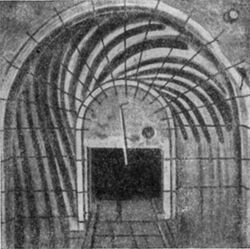Physics:Tea leaf paradox
File:Tea Leaf Paradox Stirring.ogv

In fluid dynamics, the tea leaf paradox is a phenomenon where tea leaves in a cup of tea migrate to the center and bottom of the cup after being stirred rather than being forced to the edges of the cup, as would be expected in a spiral centrifuge.
The correct physical explanation of the paradox was for the first time given by James Thomson in 1857. He correctly connected the appearance of secondary flow (both Earth atmosphere and tea cup) with ″friction on the bottom″.[2] The formation of secondary flows in an annular channel was theoretically treated by Joseph Valentin Boussinesq as early as in 1868.[3] The migration of near-bottom particles in river-bend flows was experimentally investigated by A. Ya. Milovich in 1913.[1] The solution first came from Albert Einstein in a 1926 paper in which he explained the erosion of river banks, and repudiated Baer's law.[4][5]
Explanation
The stirring makes the water spin in the cup, causing a centrifugal force outwards. Near the bottom however, the water is slowed by friction. Thus the centrifugal force is weaker near the bottom than higher up, leading to a secondary circular (helical) flow that goes outwards at the top, down along the outer edge, inwards along the bottom, bringing the leaves to the center, and then up again.[5]
Applications
The phenomenon has been used to develop a new technique to separate red blood cells from blood plasma,[6][7] to understand atmospheric pressure systems,[8] and in the process of brewing beer to separate out coagulated trub in the whirlpool.[9]
See also
- Earth:Baer–Babinet law, also known as Baer's law – Theory on the formation of rivers due to Earth's rotation
- Earth:Ekman layer – Force equilibrium layer in a liquid
- Physics:Secondary flow – Relatively minor flow superimposed on the primary flow by inviscid assumptions
References
- ↑ Jump up to: 1.0 1.1 His results are cited in: Joukovsky N.E. (1914). "On the motion of water at a turn of a river". Matematicheskii Sbornik 29. Reprinted in: Collected works. 4. Moscow; Leningrad. 1937. pp. 193–216; 231–233 (abstract in English). http://books.e-heritage.ru/book/10075055.
- ↑ James Thomson, On the grand currents of atmospheric circulation (1857). Collected Papers in Physics and Engineering, Cambridge Univ., 1912, 144-148 djvu file
- ↑ Boussinesq J. (1868). "Mémoire sur l'influence des frottements dans les mouvements réguliers des fluides". Journal de mathématiques pures et appliquées. 2e Série 13: 377–424. http://portail.mathdoc.fr/JMPA/PDF/JMPA_1868_2_13_A17_0.pdf.
- ↑ Bowker, Kent A. (1988). "Albert Einstein and Meandering Rivers". Earth Science History 1 (1): 45. doi:10.17704/eshi.7.1.yk72n55q84qxu5n6. Bibcode: 1988ESHis...7...45B. http://www.searchanddiscovery.net/documents/Einstein/albert.htm. Retrieved 2008-12-28.
- ↑ Jump up to: 5.0 5.1 Einstein, Albert (March 1926). "Die Ursache der Mäanderbildung der Flußläufe und des sogenannten Baerschen Gesetzes". Die Naturwissenschaften (Berlin / Heidelberg: Springer) 14 (11): 223–4. doi:10.1007/BF01510300. Bibcode: 1926NW.....14..223E. English translation: The Cause of the Formation of Meanders in the Courses of Rivers and of the So-Called Baer's Law, accessed 2017-12-12.
- ↑ Arifin, Dian R.; Leslie Y. Yeo; James R. Friend (20 December 2006). "Microfluidic blood plasma separation via bulk electrohydrodynamic flows". Biomicrofluidics (American Institute of Physics) 1 (1): 014103 (CID). doi:10.1063/1.2409629. PMID 19693352. PMC 2709949. http://link.aip.org/link/?BIOMGB/1/14103/1. Retrieved 2008-12-28.
- "Einstein's Tea Leaves Inspire New Blood Separation Technique". Science Daily (Press release). January 17, 2007.
- ↑ Pincock, Stephen (17 January 2007). "Einstein's tea-leaves inspire new gadget". ABC Online. http://www.abc.net.au/science/news/stories/2007/1828408.htm.
- ↑ Tandon, Amit; Marshall, John (2010). "Einstein's Tea Leaves and Pressure Systems in the Atmosphere". The Physics Teacher 48 (5): 292–295. doi:10.1119/1.3393055. Bibcode: 2010PhTea..48..292T.
- ↑ Bamforth, Charles W. (2003). Beer: tap into the art and science of brewing (2nd ed.). Oxford University Press. p. 56. ISBN 978-0-19-515479-5. https://archive.org/details/beertapintoartsc00bamf_620.
External links
- Highfield, Roger (14 January 2008). "Dr Roger's Home Experiments". The Daily Telegraph. https://www.telegraph.co.uk/scienceandtechnology/science/sciencenews/3291786/Dr-Roger%27s-Home-Experiments.html.
- Sethi, Ricky J. (September 30, 1997). "Why do particles move towards the center of the cup instead of outer rim?". MadSci Network. http://www.madsci.org/posts/archives/1997-12/875655758.Ph.r.html.
- Booker, John R.. "Student Notes - Physics of Fluids - ESS 514/414". Department of Earth and Space Sciences, University of Washington. ch. 5.8 p. 48. http://earthweb.ess.washington.edu/roe/ESS514_notes/ch5.pdf. See also figure 25 in figures.pdf
- Stubley, Gordon D. (May 31, 2001). "Mysteries of Engineering Fluid Mechanics". Mechanical Engineering Department, University of Waterloo. http://www.ansys.com/solutions/documents/mystery.pdf.
- Einstein's 1926 article online and analyzed on BibNum (click 'Télécharger' for English) (unsecure link).
 |


